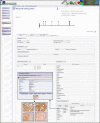Overexpression of ribosome binding protein 1 (RRBP1) in breast cancer
- PMID: 22709790
- PMCID: PMC3439379
- DOI: 10.1186/1559-0275-9-7
Overexpression of ribosome binding protein 1 (RRBP1) in breast cancer
Abstract
The molecular events that lead to malignant transformation and subsequent metastasis of breast carcinoma include alterations in the cells at genome, transcriptome and proteome levels. In this study, we used publicly available gene expression databases to identify those candidate genes which are upregulated at the mRNA level in breast cancers but have not been systematically validated at the protein level. Based on an extensive literature search, we identified ribosome binding protein 1 (RRBP1) as a candidate that is upregulated at the mRNA level in five different studies but its protein expression had not been investigated. Immunohistochemical labeling of breast cancer tissue microarrays was carried out to determine the expression of RRBP1 in a large panel of breast cancers. We found that RRBP1 was overexpressed in 84% (177/219) of breast carcinoma cases tested. The subcellular localization of RRBP1 was mainly observed to be in the cytoplasm with intense staining in the perinuclear region. Our findings suggest that RRBP1 is an interesting molecule that can be further studied for its potential to serve as a breast cancer biomarker. This study also demonstrates how the integration of biological data from available resources in conjunction with systematic evaluation approaches can be successfully applied to clinical proteomics.
Figures


References
LinkOut - more resources
Full Text Sources
Other Literature Sources
Research Materials
